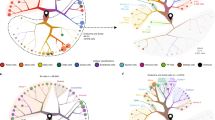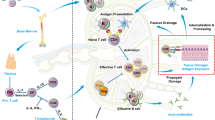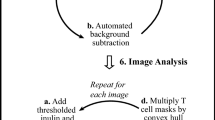Abstract
Type 1 diabetes (T1D) is an autoimmune disease characterized by the lack of insulin due to an autoimmune destruction of pancreatic beta cells. Here, we report a unique case of a family with naturally conceived quadruplets in which T1D was diagnosed in two quadruplets simultaneously. At the same time, the third quadruplet was diagnosed with the pre-diabetic stage. Remarkably, all four quadruplets were positive for anti-islet cell antibodies, GAD65 and IA-A2. Monozygotic status of the quadruplets was confirmed by testing 14 different short tandem repeat polymorphisms. Serological examination confirmed that all quadruplets and their father suffered from a recent enteroviral infection of EV68-71 serotype. To assess the nature of the molecular pathological processes contributing to the development of diabetes, immunocompetent cells isolated from all family members were characterized by gene expression arrays, immune-cell enumerations and cytokine-production assays. The microarray data provided evidence that viral infection, and IL-27 and IL-9 cytokine signalling contributed to the onset of T1D in two of the quadruplets. The propensity of stimulated immunocompetent cells from non-diabetic members of the family to secrete high level of IFN-α further corroborates this conclusion. The number of T regulatory cells as well as plasmacytoid and/or myeloid dendritic cells was found diminished in all family members. Thus, this unique family is a prime example for the support of the so-called ‘fertile-field’ hypothesis proposing that genetic predisposition to anti-islet autoimmunity is ‘fertilized’ and precipitated by a viral infection leading to a fully blown T1D.
Similar content being viewed by others
Log in or create a free account to read this content
Gain free access to this article, as well as selected content from this journal and more on nature.com
or
References
Todd JA : Etiology of type 1 diabetes. Immunity 2010; 32: 457–467.
Atkinson MA, Eisenbarth GS : Type 1 diabetes: new perspectives on disease pathogenesis and treatment. Lancet 2001; 358: 221–229.
Tree TI, Peakman M : Autoreactive T cells in human type 1 diabetes. Endocrinol Metab Clin North Am 2004; 33: 113–133.
Skowera A, Ellis RJ, Varela-Calviño R et al: CTLs are targeted to kill beta cells in patients with type 1 diabetes through recognition of a glucose-regulated preproinsulin epitope. J Clin Invest 2008; 118: 3390–3402.
Willcox A, Richardson SJ, Bone AJ et al: Analysis of islet inflammation in human type 1 diabetes. Clin Exp Immunol 2009; 155: 173–181.
Van Belle TL, Taylor P, von Herrath MG : Mouse models for type 1 diabetes. Drug Discov Today Dis Models 2009; 6: 41–45.
Tang Q, Bluestone JA : Regulatory T-cell physiology and application to treat autoimmunity. Immunol Rev 2006; 212: 217–237.
Eizirik DL, Darville MI : Beta-cell apoptosis and defense mechanisms: lessons from type 1 diabetes. Diabetes 2001; 50 (Suppl 1): S64–S69.
von Herrath M : Diabetes: a virus-gene collaboration. Nature 2009; 459: 518–519.
Kivity S, Agmon-Levin N, Blank M et al: Infections and autoimmunity – friends or foes? Trends Immunol 2009; 30: 409–414.
Bach JF : The effect of infections on susceptibility to autoimmune and allergic diseases. N Engl J Med 2002; 347: 911–920.
Zinkernagel RM : Maternal antibodies, childhood infections, and autoimmune diseases. N Engl J Med 2001; 345: 1331–1335.
Richardson SJ, Willcox A, Bone AJ et al: The prevalence of enteroviral capsid protein vp1 immunostaining in pancreatic islets in human type 1 diabetes. Diabetologia 2009; 52: 1143–1151.
Oikarinen S, Martiskainen M, Tauriainen S et al: Enterovirus RNA in blood is linked to the development of type 1 diabetes. Diabetes 2011; 60: 276–279.
Stene LC, Oikarinen S, Hyöty H et al: Enterovirus infection and progression from islet autoimmunity to type 1 diabetes: the Diabetes and Autoimmunity Study in the Young (DAISY). Diabetes 2010; 59: 3174–3180.
Staeva-Vieira T, Peakman M, von Herrath M : Translational mini-review series on type 1 diabetes: Immune-based therapeutic approaches for type 1 diabetes. Clin Exp Immunol 2007; 148: 17–31.
Bingley PJ, Williams AJ, Gale EA : Optimized autoantibody-based risk assessment in family members. Implications for future intervention trials. Diabetes Care 1999; 22: 1796–1801.
Achenbach P, Bonifacio E, Ziegler AG : Predicting type 1 diabetes. Curr Diab Rep 2005; 5: 98–103.
Cinek O, Kolousková S, Snajderova M et al: HLA class II genetic association of type 1 diabetes mellitus in Czech children. Pediatr Diabetes 2001; 2: 98–102.
CODIS (Combined DNA Index System), http://www.fbi.gov/about-us/lab/codis/codis.
Vrabelova Z, Kolouskova S, Bohmova K et al: Protein microarray analysis as a tool for monitoring cellular autoreactivity in type 1 diabetes patients and their relatives. Pediatr Diabetes 2007; 8: 252–260.
Horvath R, Budinsky V, Kayserova J et al: Kinetics of dendritic cells reconstitution and costimulatory molecules expression after myeloablative allogeneic haematopoetic stem cell transplantation: implications for the development of acute graft-versus host disease. Clin Immunol 2009; 131: 60–69.
Parazzini F, Villa A, Moroni S et al: The epidemiology of multiple pregnancies. Acta Genet Med Gemellol (Roma) 1994; 43: 17–23.
Eisenbarth GS : Molecular aspects of the etiology of type I diabetes mellitus. J Diabetes Complications 1993; 7: 142–150.
von Herrath M : Can we learn from viruses how to prevent type 1 diabetes?: the role of viral infections in the pathogenesis of type 1 diabetes and the development of novel combination therapies. Diabetes 2009; 58: 2–11.
Notkins AL : On the track of viruses. Nature 1984; 311: 209–210.
Yeung WC, Rawlinson WD, Craig ME : Enterovirus infection and type 1 diabetes mellitus: systematic review and meta-analysis of observational molecular studies. BMJ 2011; 342: d35. doi: 10.1136/bmj.d35.
Kawai T, Akira S : TLR signaling. Semin Immunol 2007; 19: 24–32.
Kawai T, Akira S : The role of pattern-recognition receptors in innate immunity: update on Toll-like receptors. Nat Immunol 2010; 11: 373–384.
Seya T, Oshiumi H, Sasai M et al: TICAM-1 and TICAM-2: toll-like receptor adapters that participate in induction of type 1 interferons. Int J Biochem Cell Biol 2005; 37: 524–529.
Siren J, Pirhonen J, Julkunen I et al: IFN-alpha regulates TLR-dependent gene expression of IFN-alpha, IFN-beta, IL-28, and IL-29. J Immunol 2005; 174: 1932–1937.
von Herrath MG, Dockter J, Oldstone MB : How virus induces a rapid or slow onset insulin-dependent diabetes mellitus in a transgenic model. Immunity 1994; 1: 231–242.
Kato H, Takeuchi O, Sato S et al: Differential roles of MDA5 and RIG-I helicases in the recognition of RNA viruses. Nature 2006; 441: 101–105.
Meylan E, Tschopp J, Karin M : Intracellular pattern recognition receptors in the host response. Nature 2006; 442: 39–44.
Nejentsev S, Walker N, Riches D et al: Rare variants of IFIH1, a gene implicated in antiviral responses, protect against type 1 diabetes. Science 2009; 324: 387–389.
Murugaiyan G, Mittal A, Lopez-Diego R et al: IL-27 is a key regulator of IL-10 and IL-17 production by human CD4+ T cells. J Immunol 2009; 183: 2435–2443.
Nowak EC, Weaver CT, Turner H et al: IL-9 as a mediator of Th17-driven inflammatory disease. J Exp Med 2009; 206: 1653–1660.
Elyaman W, Bradshaw EM, Uyttenhove C et al: IL-9 induces differentiation of TH17 cells and enhances function of FoxP3+ natural regulatory T cells. Proc Natl Acad Sci USA 2009; 106: 12885–12890.
Vrabelova Z, Hrotekova Z, Hladikova Z et al: CD 127- and FoxP3+ expression on CD25+CD4+ T regulatory cells upon specific diabetogeneic stimulation in high-risk relatives of type 1 diabetes mellitus patients. Scand J Immunol 2008; 67: 404–410.
Ryden A, Stechova K, Durilova M et al: Switch from a dominant Th1-associated immune profile during the pre-diabetic phase in favour of a temporary increase of a Th3-associated and inflammatory immune profile at the onset of type 1 diabetes. Diabetes Metab Res Rev 2009; 25: 335–343.
Stechova K, Bohmova K, Vrabelova Z et al: High T-helper-1 cytokines but low T-helper-3 cytokines, inflammatory cytokines and chemokines in children with high risk of developing type 1 diabetes. Diabetes Metab Res Rev 2007; 23: 462–471.
Salminen K, Sadeharju K, Lönnrot M et al: Enterovirus infections are associated with the induction of beta-cell autoimmunity in a prospective birth cohort study. J Med Virol 2003; 69: 91–98.
HA Guideline on Enteroviral Infection, 2nd revision www.ha.org.hk/clnguide/ev71v2.htm.
Stechova K, Kolar M, Blatny R et al: Healthy first degree relatives of patients with type 1 diabetes exhibit significant differences in basal gene expression pattern of immunocompetent cells compared to controls: expression pattern as predeterminant of autoimmune diabetes. Scand J Immunol 2011; e-pub ahead of print 16 September 2011; doi: 10.1111/j.1365-3083.2011.02637.x.
Knip M : Pathogenesis of type 1 diabetes: implications for incidence trends. Horm Res Paediatr 2011; 76 (Suppl 1): 57–64.
Redondo MJ, Yu L, Hawa M et al: Heterogeneity of type 1 diabetes. Analysis of monozygotic twins in Great Britain and the United States. Diabetologia 2001; 44: 354–362.
Oates NA, van Vliet J, Duffy DL et al: Increased DNA methylation at the AXIN1 gene in a monozygotic twin from a pair discordant for a caudal duplication anomaly. Am J Hum Genet 2006; 79: 155–162.
von Herrath MG, Fujinami RS, Whitton JL : Microorganisms and autoimmunity: making the barren field fertile? Nat Rev Microbiol 2003; 1: 151–157.
Acknowledgements
Gene expression study was exclusively supported by project NPVII 2B06019 from the Czech Ministry of Education. Studies on Tregs and DCs were supported by the project VZ MSM 0021620812 from the Ministry of Education, Youth and Sports of the Czech Republic, and by the project MZOFNM2005 from the Ministry of Health and by the project GACR P302/10/1679. AN and DF as well as the cytokine analysis were supported by the project NPVII 2B08066 from the Czech Ministry of Education, Youth and Sports. This work was also partially supported by Grant AVOZ50520514 from the Academy of Sciences of the Czech Republic.
Author information
Authors and Affiliations
Corresponding author
Ethics declarations
Competing interests
The authors declare no conflict of interest.
Additional information
Supplementary Information accompanies the paper on European Journal of Human Genetics website
Supplementary information
Rights and permissions
About this article
Cite this article
Stechova, K., Halbhuber, Z., Hubackova, M. et al. Case report: type 1 diabetes in monozygotic quadruplets. Eur J Hum Genet 20, 457–462 (2012). https://doi.org/10.1038/ejhg.2011.212
Received:
Revised:
Accepted:
Published:
Issue date:
DOI: https://doi.org/10.1038/ejhg.2011.212
Keywords
This article is cited by
-
In severe obesity, subcutaneous adipose tissue cell-derived cytokines are early markers of impaired glucose tolerance and are modulated by quercetin
International Journal of Obesity (2021)
-
Enhanced STAT3 phosphorylation and PD-L1 expression in myeloid dendritic cells indicate impaired IL-27Ralpha signaling in type 1 diabetes
Scientific Reports (2020)
-
DNA methylation in monozygotic quadruplets affected by type 1 diabetes
Diabetologia (2013)



